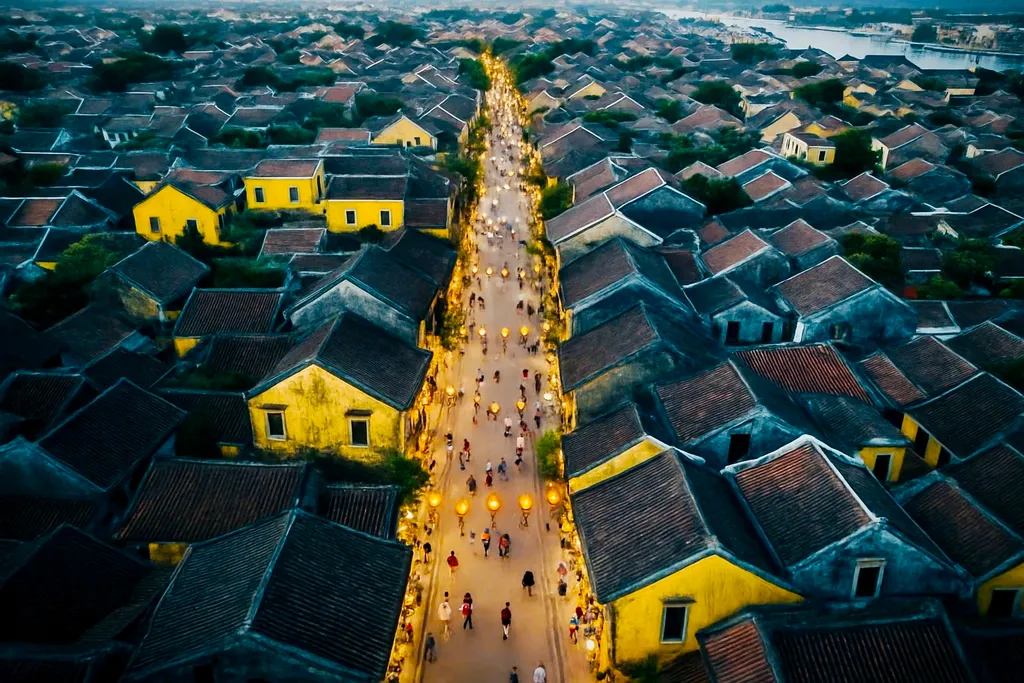Hidden stories behind Hoi An’s quiet corners
- Friday, Apr 18, 2025, 19:52 (GMT+7)
Hidden stories behind Hoi An’s quiet corners
If there’s one place on the map of Vietnam where time seems to stand still, it must be Hoi An. But not the Hoi An you’ve seen in postcards—bursting with lanterns, fluttering ao dai, and steaming bowls of Mi Quang. No, this is a different Hoi An—quieter, deeper, and strangely haunting. A Hoi An touched by memory, discovered through curious eyes and an open heart. A Hoi An that is very real, but only reveals itself when you enter with the soul of a seeker, not a tourist.
Strangely enough, the slower you move, the more Hoi An opens up. In the soft morning light, dewdrops shimmer on old cobblestones, whispering stories that haven’t been told in centuries. Most visitors pass by the Japanese Covered Bridge, thinking it’s just a picturesque old crossing. Few know it’s the only bridge-temple in Vietnam that doesn't worship Buddha. Inside, it enshrines Bac De Tran Vu, a Northern deity who guards the land from floods and misfortune. The bridge has another name, Lai Vien Kieu—“Bridge for Those Who Come From Afar.” Once a symbol of cross-border love affairs, silent business deals, and goodbyes that were never written into poems.
But Hoi An is not just a bridge, nor a town of moss-covered rooftops. If you wander away from the main street, you’ll stumble upon a quiet alley where a sun-scorched yellow wall peels like a scar of time. Instagram loves it, but few know it’s the remains of an old chapel split in half by wartime bombings. Locals rarely speak of it anymore. Yet every dawn, elders passing by still lower their heads—an unspoken nod to something lost.
Tan Ky Ancient House is a perfect time capsule. More than 200 years old, it still gleams with polished wooden floors, dark ironwood pillars, and red-gold carvings lovingly preserved by seven generations. In one dim corner hangs a black-and-white photo of the third-generation owner cross-legged beside a Western visitor—two pairs of eyes meeting in what feels like a moment suspended outside time. Japan’s Crown Prince once stood still before a timber beam marked with ink dots—each one recording a flood. “Every dot is an era,” he said. And he was right. Hoi An doesn’t fight the floods. It dances with time, gracefully, like a river learning how to flow around stone.
There’s something else that often surprises visitors—Hoi An has a Japanese burial ground. Hidden deep in a narrow alley, it’s where 17th-century Japanese merchants, who lived and loved here until their final days, found rest. Moss blankets the tombstones carved with faint kanji, next to stone circles symbolizing eternal vows. These men didn’t come to conquer. They came to trade, to love, to stay. Some left entire families across the sea just to live quietly here—like shadows beneath the old town trees.
In the Fujian Assembly Hall, an ancient incense burner has never stopped smoking. The caretaker is a third-generation woman of Chinese descent. Every morning, she steps in and lights a long coil of incense—always. “If the smoke stops rising, this place would no longer be Hoi An,” she says, like casting a gentle spell. People come to pray—for luck, for love, for peace. Few know of the legend: on a full moon night, if someone sees the lotus bloom in the carving above the entrance, they’ll be granted a year of fulfillment. But the flower only appears under a precise angle of light—Hoi An’s way of inviting you to slow down, and wait.
There’s a craft in Hoi An thought to be extinct—lantern-making by mouth. Without using hands, artisans blow bamboo into round frames and shape the joints with their lips. Only a few masters remain, tucked away in tiny lofts. They don’t run big workshops. They sell only to those patient enough to find them or beg to learn. These imperfect lanterns—with their subtle bends and off-center joints—have become Hoi An’s most honest symbol: beauty that doesn’t need correcting.
On full moon nights, the old town becomes a still painting. No horns, no electric lights. People float paper lanterns down the Hoai River, whispering hopes into the night. But behind the glow, inside old wooden homes, families hold quiet rituals—lighting oil lamps for ancestors, reciting old tales, pouring tea for no one. That’s when Hoi An is most beautiful. Not trying to impress, not putting on a show—just being itself. Raw, reverent, and wrapped in quiet magic.
There are things in Hoi An that can’t be photographed. Like the echo of footsteps in an empty corridor that feel borrowed from another century. Like the hint of incense that slips through an open window. Like the river breeze brushing past wooden shutters. Like the gaze of a street-side vendor watching the sunset melt over the rooftops, unmoved, unhurried.
Hoi An is not a place you go to “tick a box.” It’s not a backdrop for check-ins. It’s a place to rediscover something inside yourself—a long-forgotten feeling, a memory without a name, or simply a rare pause in a noisy life.
You might come to Hoi An for the lanterns. But if you stay a little longer, you’ll leave with something else. Something not on the map. Not in the guidebooks. Something only you will know—because you truly lived each moment in the ancient town.
If there’s one place in Vietnam that will make you whisper, “Why didn’t I come here sooner?”—it’s Hoi An. And perhaps, in a world that spins too fast, a city that chooses to move slowly is the kind of magic we all need to find at least once.

 CHECKIN.VN
CHECKIN.VN








Share on